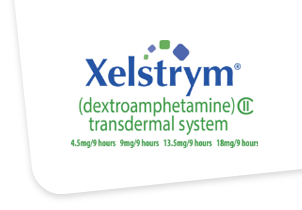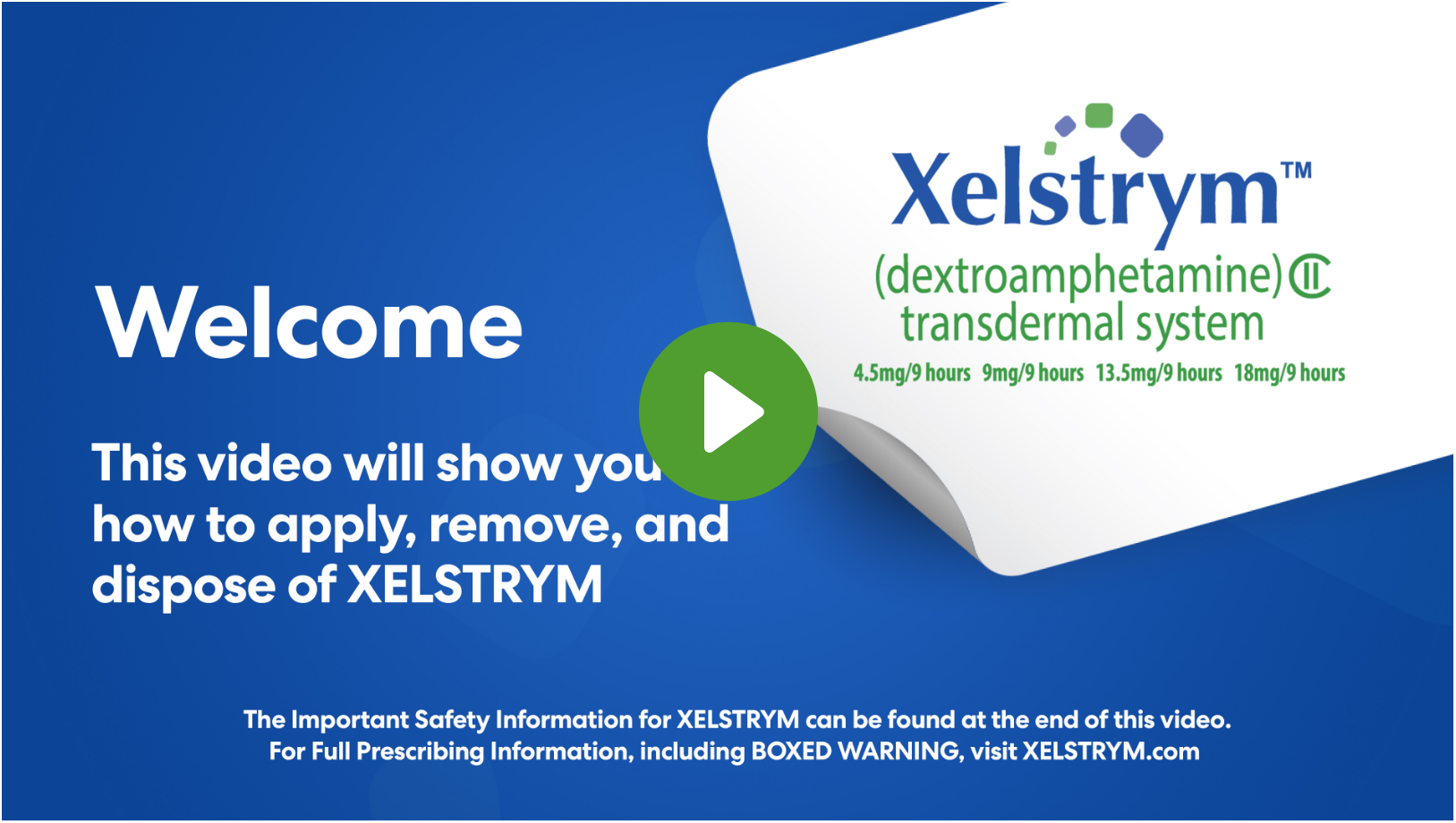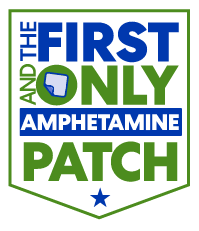
 Recommended starting dose for adults: 9 mg/9 hrs1
Recommended starting dose for adults: 9 mg/9 hrs1
- Adult dosage may be adjusted up to a maximum recommended dose of 18 mg/9 hrs
- Recommended starting dose for children and adolescents, aged 6 to 17 years: 4.5 mg/9 hrs
- Dosage may be adjusted in weekly increments of 4.5 mg up to a maximum recommended dose of 18 mg/9 hrs
- Dose titration and final dosage should be individualized depending on clinical response and tolerability
- XELSTRYM should be removed within 9 hours after application
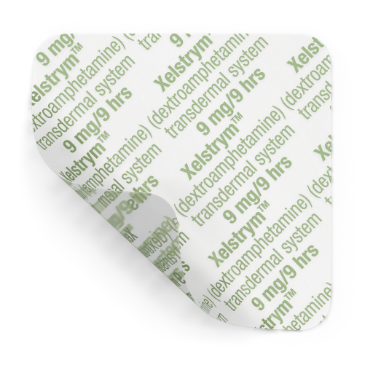
Help your patients get started and stay on track with their treatment
The Mindful Patch app can help patients keep track of patch application sites and usage trends. This may provide insights to help inform collaborative treatment discussions.
Learn more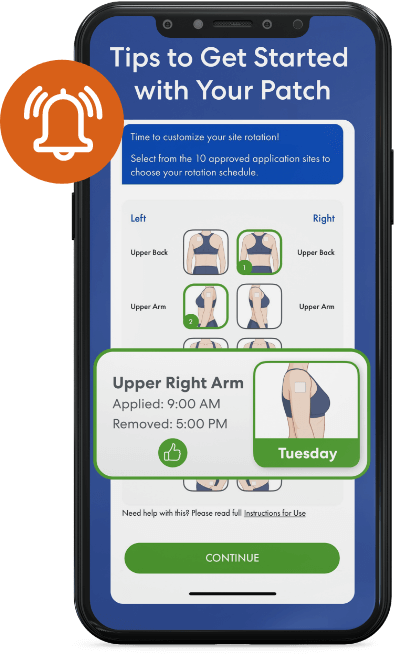
Prior to initiating XELSTRYM1
- Assess for the presence of cardiac disease1
- Assess the risk of abuse prior to prescribing and monitor for signs of abuse and dependence while on therapy1
- Maximum doses for compromised patients
- Severe renal impairment: Maximum dose is 13.5 mg/9 hours1
- End stage renal disease: Maximum dose is 9 mg/9 hours1
- Evaluate family history and clinically evaluate patients for motor or verbal tics or Tourette’s1
 XELSTRYM offers 10 approved application wear sites
XELSTRYM offers 10 approved application wear sites
- Usage: one patch daily (per 24 hours)
- Do not wear the patch for more than 9 hours
- Application site should be changed when a new patch is applied
Choose from the left or right side of the body

When can my patients wear the patch?1
| YES | AVOID | |
|---|---|---|
| Showering* | ||
| Bathing* | ||
| Swimming* | ||
| Activities that cause sweating† | ||
| Direct heat‡ |
*Patients should check to see if the patch has become loose after bathing, showering, or swimming.
†Patients should check their patch fit if they sweat excessively.
‡After applying XELSTRYM, patients should avoid exposing the application site to direct external heat sources, such as hair dryers, heating pads or electric blankets, heat lamps, saunas, hot tubs, and heated water beds. Exposure to heat can cause too much medicine to pass into their body and cause serious side effects.
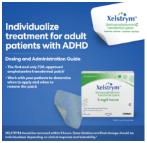
Download the Dosing and Administration
Guide for XELSTRYM
Reference: 1. XELSTRYM (dextroamphetamine) transdermal system, CII [package insert]. Miami, FL. Noven Therapeutics LLC. October, 2023.
XELSTRYM (dextroamphetamine) transdermal system, CII is indicated for the treatment of Attention Deficit Hyperactivity Disorder (ADHD) in adult and pediatric patients 6 years and older. The use of XELSTRYM is not recommended in pediatric patients younger than 6 years of age because they had higher plasma exposure and a higher incidence of adverse reactions (e.g., weight loss) than patients 6 years and older at the same dosage.
IMPORTANT SAFETY INFORMATIONXELSTRYM has a high potential for abuse and misuse, which can lead to the development of a substance use disorder, including addiction. Misuse and abuse of CNS stimulants, including XELSTRYM, can result in overdose and death, and this risk is increased with higher doses or unapproved methods of administration, such as snorting or injection.
Before prescribing XELSTRYM, assess each patient’s risk for abuse, misuse, and addiction. Educate patients and their families about these risks, proper storage of the drug, and proper disposal of any unused drug. Throughout XELSTRYM treatment, reassess each patient’s risk of abuse, misuse, and addiction and frequently monitor for signs and symptoms of abuse, misuse, and addiction.
- Known hypersensitivity to amphetamine products or other components in XELSTRYM. Anaphylactic reactions, Stevens-Johnson Syndrome, angioedema, and urticaria have been observed.
- Use with monoamine oxidase inhibitors (MAOIs), or within 14 days of stopping MAOIs (including linezolid or intravenous methylene blue) due to increased risk of hypertensive crisis.
Risks to Patients with Serious Cardiac Disease: Avoid XELSTRYM use in patients with known structural cardiac abnormalities, cardiomyopathy, serious cardiac arrhythmia, coronary artery disease, or other serious cardiac diseases. Sudden death has been reported in patients with structural cardiac abnormalities or other serious cardiac disease who were treated with CNS stimulants at the recommended ADHD dosage.
Increased Blood Pressure and Heart Rate: CNS stimulants cause an increase in blood pressure (mean increase about 2 to 4 mm Hg) and heart rate (mean increase about 3 to 6 bpm). Monitor all patients for potential tachycardia and hypertension.
Psychiatric Adverse Reactions: Exacerbation of Pre-existing Psychosis: May exacerbate symptoms of behavior disturbance and thought disorder in patients with a pre-existing psychotic disorder. Induction of a Manic Episode in Patients with Bipolar Disorder: May induce a mixed/manic episode in patients. Prior to initiating XELSTRYM treatment, screen for risk factors for developing a manic episode (e.g., comorbid or history of depressive symptoms, or a family history of suicide, bipolar disorder, and depression). New Psychotic or Manic Symptoms: At recommended doses, may cause psychotic or manic symptoms (e.g., hallucinations, delusional thinking, or mania) in patients with no prior history of psychotic illness or mania. Discontinue XELSTRYM if symptoms occur.
Long-Term Suppression of Growth in Pediatric Patients: XELSTRYM is not approved for use and is not recommended in pediatric patients below 6 years of age. CNS stimulants have been associated with weight loss and slowing of growth rate in pediatric patients. Closely monitor growth (weight and height). Treatment may need to be interrupted in pediatric patients not growing or gaining weight as expected. XELSTRYM is not approved for use in pediatric patients below 6 years of age.
Peripheral Vasculopathy, including Raynaud’s Phenomenon: Stimulants, including XELSTRYM, are associated with peripheral vasculopathy, including Raynaud’s phenomenon. Signs and symptoms are usually intermittent and mild; very rare sequelae include digital ulceration and/or soft tissue breakdown. Careful observation for digital changes is necessary during treatment with stimulants. Further evaluation including rheumatology referral, may be appropriate for certain patients.
Serotonin Syndrome: Risk is increased when XELSTRYM is co-administered with serotonergic agents (e.g., SSRIs, SNRIs, triptans), and with CYP2D6 inhibitors. If it occurs, discontinue XELSTRYM and initiate supportive treatment.
Contact Sensitization: Use of XELSTRYM may lead to contact sensitization. Discontinue XELSTRYM if contact sensitization is suspected.
Application Site Reactions: During wear time or immediately after removal of XELSTRYM, local skin reactions such as pain, pruritus, burning sensation, erythema, discomfort, edema, and/or swelling were reported. Select a different application site each day to minimize skin reactions.
External Heat: Avoid exposing XELSTRYM to direct external heat sources during wear because both the rate and extent of absorption are increased.
Motor and Verbal Tics, and Worsening of Tourette’s Syndrome: Before initiating XELSTRYM, assess the family history and clinically evaluate patients for tics or Tourette’s syndrome. Regularly monitor XELSTRYM-treated patients for the emergence or worsening of tics or Tourette’s syndrome, and discontinue treatment if clinically appropriate. CNS stimulants, including methylphenidate, have been associated with the onset or exacerbation of motor and verbal tics. Worsening of Tourette’s syndrome has also been reported.
ADVERSE REACTIONSMost common adverse reactions (incidence ≥2% and greater than the rate for placebo) in pediatric patients 6 to 17 years treated with XELSTRYM were: decreased appetite, headache, insomnia, tic, abdominal pain, vomiting, nausea, irritability, increased blood pressure, and increased heart rate.
Most common adverse reactions (incidence of ≥5% and a rate at least twice placebo) in adults treated with lisdexamfetamine were: decreased appetite, insomnia, dry mouth, diarrhea, nausea, and anxiety.
USE IN SPECIFIC POPULATIONSPregnancy and Lactation: XELSTRYM may cause fetal harm. Breastfeeding is not recommended during XELSTRYM treatment.
Pediatric Use: The safety and effectiveness of XELSTRYM have not been established in pediatric patients below the age of 6 years.
Please click here for full Prescribing Information, including BOXED WARNING.
XELSTRYM (dextroamphetamine) transdermal system, CII is indicated for the treatment of Attention Deficit Hyperactivity Disorder (ADHD) in adult and pediatric patients 6 years and older. The use of XELSTRYM is not recommended in pediatric patients younger than 6 years of age because they had higher plasma exposure and a higher incidence of adverse reactions (e.g., weight loss) than patients 6 years and older at the same dosage.
IMPORTANT SAFETY INFORMATIONXELSTRYM has a high potential for abuse and misuse, which can lead to the development of a substance use disorder, including addiction. Misuse and abuse of CNS stimulants, including XELSTRYM, can result in overdose and death, and this risk is increased with higher doses or unapproved methods of administration, such as snorting or injection.
Before prescribing XELSTRYM, assess each patient’s risk for abuse, misuse, and addiction. Educate patients and their families about these risks, proper storage of the drug, and proper disposal of any unused drug. Throughout XELSTRYM treatment, reassess each patient’s risk of abuse, misuse, and addiction and frequently monitor for signs and symptoms of abuse, misuse, and addiction.
- Known hypersensitivity to amphetamine products or other components in XELSTRYM. Anaphylactic reactions, Stevens-Johnson Syndrome, angioedema, and urticaria have been observed.
- Use with monoamine oxidase inhibitors (MAOIs), or within 14 days of stopping MAOIs (including linezolid or intravenous methylene blue) due to increased risk of hypertensive crisis.
Risks to Patients with Serious Cardiac Disease: Avoid XELSTRYM use in patients with known structural cardiac abnormalities, cardiomyopathy, serious cardiac arrhythmia, coronary artery disease, or other serious cardiac diseases. Sudden death has been reported in patients with structural cardiac abnormalities or other serious cardiac disease who were treated with CNS stimulants at the recommended ADHD dosage.
Increased Blood Pressure and Heart Rate: CNS stimulants cause an increase in blood pressure (mean increase about 2 to 4 mm Hg) and heart rate (mean increase about 3 to 6 bpm). Monitor all patients for potential tachycardia and hypertension.
Psychiatric Adverse Reactions: Exacerbation of Pre-existing Psychosis: May exacerbate symptoms of behavior disturbance and thought disorder in patients with a pre-existing psychotic disorder. Induction of a Manic Episode in Patients with Bipolar Disorder: May induce a mixed/manic episode in patients. Prior to initiating XELSTRYM treatment, screen for risk factors for developing a manic episode (e.g., comorbid or history of depressive symptoms, or a family history of suicide, bipolar disorder, and depression). New Psychotic or Manic Symptoms: At recommended doses, may cause psychotic or manic symptoms (e.g., hallucinations, delusional thinking, or mania) in patients with no prior history of psychotic illness or mania. Discontinue XELSTRYM if symptoms occur.
Long-Term Suppression of Growth in Pediatric Patients: XELSTRYM is not approved for use and is not recommended in pediatric patients below 6 years of age. CNS stimulants have been associated with weight loss and slowing of growth rate in pediatric patients. Closely monitor growth (weight and height). Treatment may need to be interrupted in pediatric patients not growing or gaining weight as expected. XELSTRYM is not approved for use in pediatric patients below 6 years of age.
Peripheral Vasculopathy, including Raynaud’s Phenomenon: Stimulants, including XELSTRYM, are associated with peripheral vasculopathy, including Raynaud’s phenomenon. Signs and symptoms are usually intermittent and mild; very rare sequelae include digital ulceration and/or soft tissue breakdown. Careful observation for digital changes is necessary during treatment with stimulants. Further evaluation including rheumatology referral, may be appropriate for certain patients.
Serotonin Syndrome: Risk is increased when XELSTRYM is co-administered with serotonergic agents (e.g., SSRIs, SNRIs, triptans), and with CYP2D6 inhibitors. If it occurs, discontinue XELSTRYM and initiate supportive treatment.
Contact Sensitization: Use of XELSTRYM may lead to contact sensitization. Discontinue XELSTRYM if contact sensitization is suspected.
Application Site Reactions: During wear time or immediately after removal of XELSTRYM, local skin reactions such as pain, pruritus, burning sensation, erythema, discomfort, edema, and/or swelling were reported. Select a different application site each day to minimize skin reactions.
External Heat: Avoid exposing XELSTRYM to direct external heat sources during wear because both the rate and extent of absorption are increased.
Motor and Verbal Tics, and Worsening of Tourette’s Syndrome: Before initiating XELSTRYM, assess the family history and clinically evaluate patients for tics or Tourette’s syndrome. Regularly monitor XELSTRYM-treated patients for the emergence or worsening of tics or Tourette’s syndrome, and discontinue treatment if clinically appropriate. CNS stimulants, including methylphenidate, have been associated with the onset or exacerbation of motor and verbal tics. Worsening of Tourette’s syndrome has also been reported.
ADVERSE REACTIONSMost common adverse reactions (incidence ≥2% and greater than the rate for placebo) in pediatric patients 6 to 17 years treated with XELSTRYM were: decreased appetite, headache, insomnia, tic, abdominal pain, vomiting, nausea, irritability, increased blood pressure, and increased heart rate.
Most common adverse reactions (incidence of ≥5% and a rate at least twice placebo) in adults treated with lisdexamfetamine were: decreased appetite, insomnia, dry mouth, diarrhea, nausea, and anxiety.
USE IN SPECIFIC POPULATIONSPregnancy and Lactation: XELSTRYM may cause fetal harm. Breastfeeding is not recommended during XELSTRYM treatment.
Pediatric Use: The safety and effectiveness of XELSTRYM have not been established in pediatric patients below the age of 6 years.
Please click here for full Prescribing Information, including BOXED WARNING.
